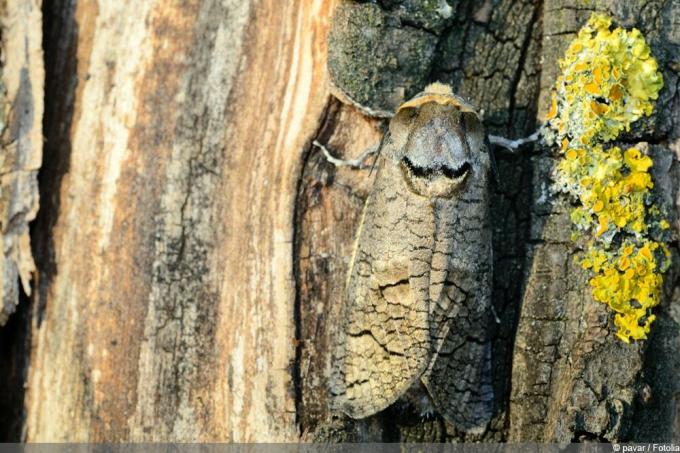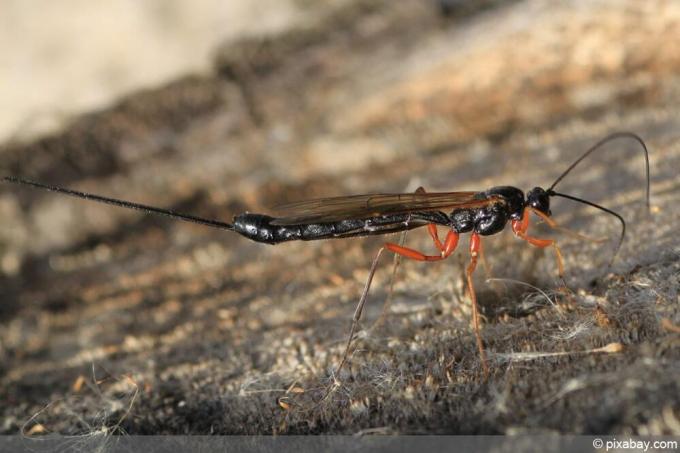

Table of contents
- Characteristics
- toxicity
- damage picture
- Natural enemies
- prevention
- combat
- quassia broth
- insecticide
- parasitic wasps
- kill caterpillars
- Cut away affected parts
- Conclusion
Small willow borer caterpillars compete against a large tree and still win the duel. Time is her secret ally and of course her diligence. Even if it takes years, at some point every tree gives up. Too many holes run through the trunk and weaken its vitality. Hurry is required to block the caterpillars' way into the deepest interior of the fruit trees.
Characteristics
- Willow borer is a species of butterfly (moth)
- comes from the family of wood borers
- Cossus cossus is its scientific name
- affects only deciduous trees
- Willows are preferred host plants, but so are apple and pear trees
- the moth is hairy, the wings mottled grey-brown
- Wingspan: up to 8 cm in males, 10 cm in females
- crepuscular and nocturnal
- Larvae reach a length of up to 10 cm
- strong red coloration, black neck plate
toxicity
The caterpillar itself is not poisonous. But she has powerful cutting tools and knows how to defend herself. That hurts. Direct contact with it can also cause skin irritation.
damage picture

The moth is well camouflaged in color on the tree bark, the caterpillars stick deep into the tree trunk. How can an infestation be clearly and, above all, identified in good time? It is the tracks left behind that give clear indications of the presence of the willow borer.
- Bark shows large round-oval boreholes
- there is reddish drill dust in the openings
- the caterpillar droppings are transported out of the borehole
- it can therefore also be discovered at the hole opening
- large areas of the brittle bark can be detached
- the tree gives off a strong smell of vinegar
The typical smell of vinegar is an invitation to other moths. They also lay their eggs, which gives a powerful boost to the progression of the infestation. The damage done is now clearly visible on the tree.
- withered branches
- withering leaves
In the final stages of infestation, the tree eventually dies.
Tip:
A heavily punctured tree loses stability and can snap off "unexpectedly". The falling parts of the tree pose a danger. Precautionary felling is advisable if the infestation is known and can no longer be contained.
Natural enemies
The willow borer has some natural enemies in this country:
- birds of prey
- woodpeckers
- parasitic wasps
However, even these enemies are powerless against the caterpillars hidden deep in the trunk.
prevention
Keeping moths away from your own fruit trees is impossible. There is no suitable means available to make the tree less attractive to this pest. It therefore only remains to check the tree regularly in order to at least discover the infestation at an early stage.
- check twice a year
- especially in areas where the willow borer occurs frequently
- look for laid eggs in June and July
- from July to September check the trunk for openings
- especially the part near the ground
combat

Controlling the willow borer is not easy. The caterpillars that do the damage hide inside the tree and are difficult to reach. Only in their early stages are they close to the surface and therefore easier to access. Unfortunately, only a few means are available to combat it. It is not always certain that the tree will actually be saved. Spreading to nearby trees is possible at any time, which increases the pressure to succeed. An emergency felling is often the only way to limit the impact of the red caterpillars.
quassia broth
Quassia wood is a very special kind of bitter wood. The active ingredient quassin it contains is deadly for numerous species of vermin, including the eggs and newly hatched larvae of the willow borer. In order to extract quassin from the bitterwood, a broth must be prepared. You can easily make this natural pesticide yourself.
- You will need 150 grams of bitterwood. Pour 2 liters of water over it and leave it like that for a day.
- Boil the solution vigorously for one hour.
- Sieve out the wood chips and let them dry. They can be reused up to three times.
- Before applying, dilute the broth with 10 l of water.
- Periodically spray the tree trunk with the quassia broth. Rinse the covering with clear water after 2-3 days. Begin treatment in early spring and continue through fall. The broth is stable over the entire period.
Tip:
Be careful with using quassia broth. Only spray locally. It is not only poisonous for the willow borer, but also for many beneficial insects.
insecticide
The contact poison pyrethrum is also effective against eggs and newly hatched larvae of the willow borer. Various types of chrysanthemum are the starting point for the production of insecticides with this active ingredient. Several preparations, each with different names, are available on the commercial market. The poison damages the nerve cells of the willow borer but also of other insects. It does not matter whether it is a pest or a beneficial insect. Therefore, this insecticide should also be used sparingly.
parasitic wasps

Ichneumon wasps are tiny insects that should not be confused with the dreaded large wasps. They have been used successfully against food and clothes moths for years. However, the parasitic wasps are not only specialized in these two species. This makes them interesting for controlling other moths.
- are very small, about 0.4 mm
- don't fly, they crawl
- feed on eggs and caterpillars
- are completely harmless to humans
- also for other animals and plants
- once they have eaten their food, they disappear from the scene
- die and crumble to dust
- Cards with parasitic wasps can be obtained online
kill caterpillars
Caterpillars that have already penetrated deep into the tree are hardly reached by the measures mentioned above. That's why it's extremely important not to let it get that far. However, if the infestation is discovered late, there is no choice but to leave the tree to the caterpillars or to try an extremely ruthless method. The holes that are visible from the outside are pierced with a sturdy wire. The large caterpillars are pierced by the wire and killed. This is not for sensitive minds. Unfortunately, not all caterpillars are caught in this way, but their number is definitely reduced significantly.
Cut away affected parts
If the whole tree is badly affected, it has to be felled and the rootstock dug up. If, on the other hand, only part of the branches are affected by the willow borer, a generous pruning of the affected parts can be a viable escape route.
- cut down to healthy wood
- the month of May is the ideal time
- Seal cuts with appropriate protective materials
Tip:
Regardless of whether the whole tree or just parts are felled, the professional disposal of the wood waste must always be ensured. Otherwise, the caterpillars survive in the dead wood and soon attack other trees. The most effective method of destruction is incineration.
Conclusion
Willow borers are a deadly threat to our apple and pear trees. Especially when the caterpillars remain undiscovered and hollow out the trunks undisturbed for years. On the other hand, an attentive fruit tree owner who knows the signs and takes up the fight early has a good chance of driving the caterpillars away and continuing to harvest from his fruit trees for a long time to come.
 Home editorial office
Home editorial office
Learn more about pests

Ants in the raised bed: what to do?
If ants are found in the raised bed, quick action is required. With the right means and measures, however, the insects can be easily controlled or driven away.

Fight vine weevil: 6 home remedies
The vine weevil is only a problem in the garden when it occurs in large numbers. The beetle eats the leaves, the damage to the larvae is much greater. They eat at the roots and can also cause plants to die off.

Big holes in the garden: which animal was it?
Whether in the lawn or "just" in flower beds, holes in the ground make no gardener happy. But who causes the holes? And how do you get rid of them? We explain causes and strategies for annoying visitors underground.

Combat Little Red Spider | 7 tips for garden & balcony
Although the little red spider is harmless because it neither stings nor transmits diseases, its occurrence is still a thorn in the side of many people. The little creatures become particularly annoying when they are not just limited to infesting plants, but also spread out on the balcony or even in the apartment. Fortunately, effective biological measures exist to control the arachnids.

Rats in the garden: what to do? How to fight the plague of rats
Many people are disgusted just at the thought of rats: after all, the harmful rodents have been considered carriers of dangerous diseases for thousands of years. The animals also cause considerable damage in the house and in the garden. This is how you get rid of the plague again - sustainably and effectively.

Ultrasonic Rat Control – Does Ultrasound Help Against Pests?
Rats in the house or in the garden are not only disgusting, they can also quickly become a problem. But what can you do about it? Ultrasonic rat control is often recommended. However, the method is very controversial. More about this is here.



